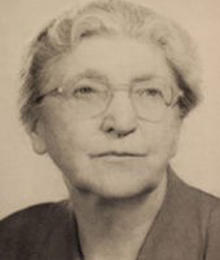International Women’s Day 2020: Celebrating the women who helped establish the Society
06 March 2020

It’s International Women’s Day this Sunday, and we are celebrating the achievements of two women who were part of founding the Microbiology Society, Marjory Stephenson and Muriel Robertson.
Marjory Stephenson
Marjory Stephenson (1885–1948) was a biochemist and the second President of the Microbiology Society, then the Society for General Microbiology, and its first female President. She was President from 1947–1948 and played an active part in the founding of the Society.
Marjory was born on 24 January 1885 at Burwell, near Cambridge, where she graduated from Newnham College. Her career as a biochemist started at University College London and, during the First World War, she ran hospital kitchens in France and worked as a VAD in Greece. She was awarded an MBE in recognition of her service.
After the war she returned to Cambridge to work in the Department of Biochemistry, working on bacterial metabolism and the study of intracellular enzymes, with particular emphasis on oxidation mechanisms. Together with Margaret Whetham and Juda Quastel, she developed the washed suspension technique, which had originated from Louis Pasteur, for extracting enzymes from bacteria. She was appointed as a lecturer in biochemistry at the University of Cambridge in 1943.
In 1945, Marjory was one of the first two women elected as a Fellow of the Royal Society. She died in 1948, one year after being appointed Reader in Chemical Microbiology at the University of Cambridge. The Microbiology Society established the Marjory Stephenson Prize in her honour in 1953, awarded annually to an individual who has made exceptional contributions to the discipline of microbiology.
Muriel Robertson

Muriel Robertson (1883–1973) was a protozoologist and bacteriologist at the Lister Institute, London, from 1915 to 1961. She was one of the founding members of the Microbiology Society and served as a Council member from 1945 to 1948.
Muriel was born in Glasgow and graduated from the University of Glasgow with a Master of Arts in 1905. She was known for her work on trypanosomes, studying trypanosome infections in reptiles in Ceylon and Trypanosoma brucei gambiense in Uganda. She became a Doctor of Science at the University of Glasgow in 1923 after writing her thesis on the ‘life histories of certain trypanosomes’. She worked at the Lister Institute in London from 1915 to 1961.
Muriel was elected a Fellow of the Royal Society in 1947. She was a Fellow of the Royal Society of Tropical Medicine and the Institute of Biology and a member of the Pathological Society, the Society for Experimental Biology and the Medical Research Club. She became an Honorary Doctor at the University of Glasgow in 1948. The Society made her an Honorary Member in 1962, and on her 80th birthday in 1963 she delivered the Marjory Stephenson Memorial Lecture.
Learn more about the key people who helped form the Society in the ‘Our history’ section of the website.
